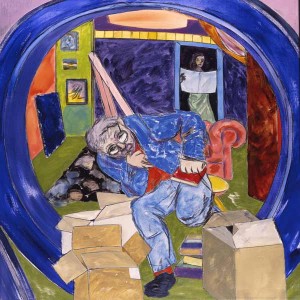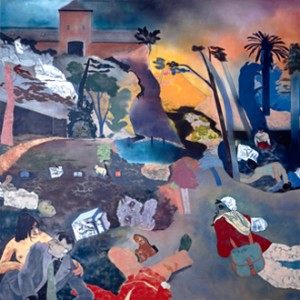Kitaj once said that books are for him what trees are for a landscape painter. His ateliers in the London neighborhood of Chelsea and in Westwood, Los Angeles, were crammed full of books, on shelves, around his easels and piled up on the floor.
He was already ranging through the cheap bookshops on 4th Avenue – the largest bookselling district in the world – on his way to Cooper Union when he was a student there. He found the modern classics like James Joyce, Ezra Pound, T.S. Eliot, and Kafka, as well as journals such as the “Partisan Review” and the American surrealist magazine “View.” In Oxford, his teacher Edgar Wind introduced him to the Warburg School and he bought a complete set of the famous “Journals of the Warburg Institute.” His visual imagination was fuelled by the illustrations for the “Afterlife of Antiquity,” copperplate engravings made according to ancient templates. In 1969, Kitaj published as silkscreens 50 book jackets from his personal library, in an edition that he called “In Our Time: Covers for a Small Library after the Life for the Most Part.”
Kitaj gave many of his works titles derived from books, such as “The Autumn of Central Paris,” which describes the expulsion of the proletariat from central Paris to the periphery, or “If Not, Not,” which plays on the oath of the Aragonese in the Middle Ages.
Above all, however, book illustrations were the source for many pictures, for instance the image of Fidgety-Philip tipping over in his chair, from the children’s book by Heinrich Hoffmann “Slovenly Peter,” that appears in the painting “London by Night.”
In his self-portrait “Unpacking My Library” (1990/91), Kitaj appears while unpacking boxes of his books. The title of the picture alludes to Walter Benjamin’s famous essay “I unpack my library. A talk on collecting” from 1931, which Kitaj read in the first English edition of Benjamin’s “Illuminations” in 1968. The artist identified himself with Benjamin as a book collector, by donning latter’s eyeglasses and mustache in his picture. The sight of books scattered around packing boxes unleashes a “tidal wave of memories,” so said Benjamin, before the “quiet boredom of order” on the shelves erects a dam against it. Both men could recall the adventurous story of how they discovered and purchased each book.
All of Kitaj’s impressions, what he read, what he saw, what struck him, and what happened to him – he documented it all in his pictures. In this sense, they are “all autobiographical.” Thus the pictures and the books of his library became his Heimat, his real, his emotional, home.
Eckhart Gillen, Curator
For more on R.B. Kitaj, see: www.jmberlin.de/kitaj/en

